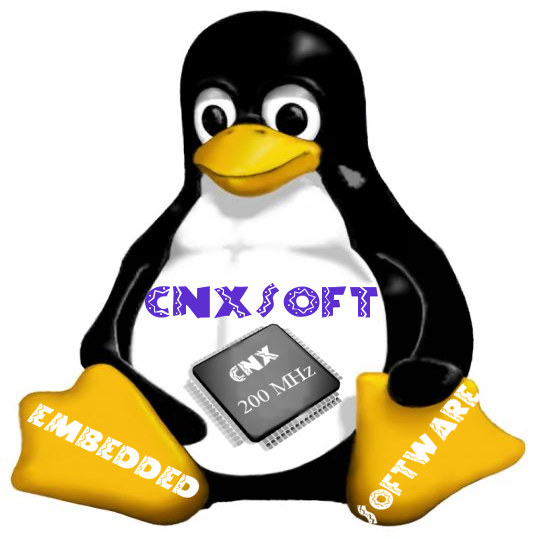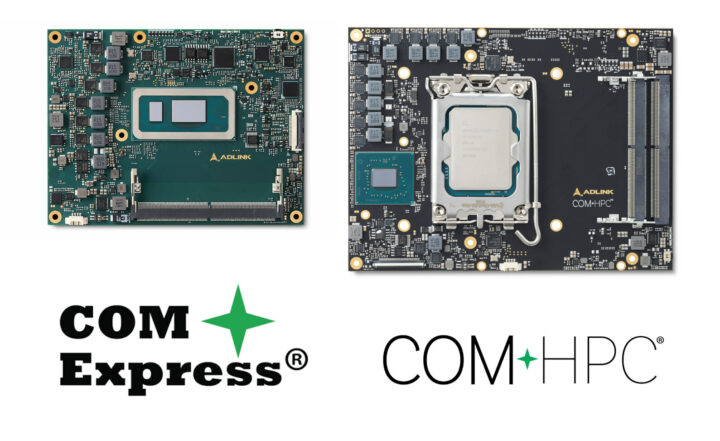ADLINK Technology introduced the COM-HPC-cRLS (Raptor Lake-S) COM-HPC size C module and Express-RLP Raptor Lake-P COM Express Type 6 module at the beginning of the year, and while we covered the specifications for both in detail at the time of the announcement, we’ll compare the advantages and benefits of the two types of 13th generation Raptor Lake modules in this post and compare 12th gen Alder Lake-S and 13th Gen Raptor Lake-S processor performance to help potential buyers select the right one for their applications.
Raptor Lake COM-HPC vs COM Express vs modules
| COM-HPC-cRLS (Raptor Lake-S) | Express-RLP (Raptor Lake-P) |
|---|---|
| COM-HPC Client type, Size C | Latest COM Express R3.1 standard |
| Up to 24 cores (8P+16E) and increased cache as 36MB (compare to 12th Gen Core 30MB) | Up to 14 core (6P+8E), 24MB cache. |
| SKU up to I9 SKU in 65W TDP | Wide range of TDP SKU support from 45W to 15W |
| Up to 128GB, DDR5 5600MT/s, IBECC (selected SKU) | Up to 64GB, DDR5 4800MT/s |
| 1 x16 PCIe Gen5 (advantage of COM-HPC) | Integrated Xe Graphic Engine for Media, Graphic and AI application |
| Embedded Use condition | Embedded/Industrial Use condition |
| BGA type and PCB materials built for rugged/critical usage |
The table above provides a high-level comparison between the COM-HPC-cRLS (Raptor Lake-S) and the Express-RLP (Raptor Lake-P) modules. The Raptor Lake-S socketed processor family found in the COM-HPC provides more processing power, supports up to 128GB DDR5, and the COM-HPC standard adds support for PCIe Gen5 which is not possible with the COM Express standard. The Raptor Lake-P processor family has its own advantages with an integrated Intel Xe graphics engine for media playback, AI acceleration, and 3D graphics, plus the Express-RLP module is better suited to rugged/critical usage thanks to the use of a Raptor Lake-P BGA processor soldered on the module.
Both Raptor Lake processors support Intel Time coordinated computing (TCC) and Time Sensitive Networking (TSN) to help achieve the high determinism required for critical factory functions.
Here’s how various applications may benefit from the key features of the COM-HPC and/or COM Express modules:
- COM-HPC’s PCIe Gen5 x16 interface
- Benefits: Up to 32GT/s to accelerate computing with graphic cards, connect high throughput FPGA, storage devices, etc…
- Target applications – Semiconductor test equipment, healthcare ultrasound equipment
- In-Band ECC (Raptor Lake-S)
- Benefit: High accuracy data reliability application in critical application
- Target applications: critical/defense applications
- AVX-512 instructions (VNNI) in Raptor Lake-P
- Benefit: Accelerating computing capability in machine learning, AI model training..etc
- Target applications: industrial automation
- Hybrid architecture (P-core & E-core)
- Benefit: more efficiently distribute core usage depending on the needs of a given application.
- Target applications: IoT, Mobile, portable devices, and other battery-operated devices.
- Real-time networking (TCC and TSN)
- Benefit: Low latency requirement in devices communicating as industrial automation
- Target applications: industrial automation
Alder Lake-S vs Raptor Lake-S performance
Another way to select a processor is its performance metric against earlier generations. ADLINK has run some benchmarks in Windows 10 IoT Enterprise LTSC with a 12th-generation Intel Core i9-12900E Alder Lake-S “embedded” processor and a 13th-generation Intel Core i9-13900E Raptor Lake-S “embedded” processor socketed on the COM-HPC-cRLS COM-HPC module. The test was possible because the processors are pin-to-pin compatible, but note that only the 13th-generation model is offered by the company.
Test configurations.
| Processor | Intel Core i9-12900E | Intel Core i9-13900E |
|---|---|---|
| Chipset | Alder Lake-S | Raptor Lake-S |
| Processor TDP (UP/Normal/Down) | Normal |
|
| Cores/Threads Number | 16C/24T | 8P+16E/32T |
| Processor Base Frequency | P 2.30Ghz/ E 1.70 GHz | P 2.00Ghz/ E 1.50 GHz |
| Max Turbo Frequency | P 5.00GHz/ E 3.80 GHz | P 5.20GHz/ E 4.20 GHz |
| Memory Channel 1 | innodisk DDR5 4800 32GB |
|
| Memory Channel 2 | innodisk DDR5 4800 32GB |
|
| Memory Channel 3 | innodisk DDR5 4800 32GB |
|
| Memory Channel 4 | innodisk DDR5 4800 32GB |
|
| Graphics | Intel UHD Graphics 770 |
|
| HDD | Samsung 860 500GB | Innodisk 3MV2-P 512GB SSD |
| BIOS | 0.07.10 |
|
| .NET Framework Version | 4.5 |
|
| DirectX | 12 |
|
| OS | Windows 10 IoT Enterprise LTSC 21H2 x64 |
|
Here are the results with SiSoftware Sandra 2018 Professional Edition.
| Core i9-12900E | Core i9-13900E | |
|---|---|---|
| CPU Arithmetic Benchmark | ||
| Aggregate Native Performance | 305.85GOPS | 370.39GOPS |
| Dhrystone Integer Native AVX2 | 390.78GIPS | 479.74GIPS |
| Dhrystone Long Native AVX2 | 413.44GIPS | 498.4GIPS |
| Whetstone Single-float Native AVX/FMA | 265.42GFLOPS | 320.83GFLOPS |
| Whetstone Double-float Native AVX/FMA | 215.9GFLOPS | 254.9GFLOPS |
| CPU Multi-Media Benchmark | ||
| Aggregate Multi-Media Native Performance | 623.61MPix/s | 722.84MPix/s |
| Multi-Media Integer Native x32 AVX2 | 821.08MPix/s | 964.6MPix/s |
| Multi-Media Long-int Native x16 AVX2 | 314.24MPix/s | 363.11MPix/s |
| Multi-Media Quad-int Native x1 ALU | 5.88MPix/s | 7.67MPix/s |
| Multi-Media Single-float Native x16 FMA | 728.54MPix/s | 839MPix/s |
| Multi-Media Double-float Native x8 FMA | 405.42MPix/s | 466.68MPix/s |
| Multi-Media Quad-float Native x4 FMA | 22.18MPix/s | 26.4MPix/s |
| CPU Multi-Core Efficiency Benchmark | ||
| Inter-Core Bandwidth | 73.46GB/s | 82.44GB/s |
| Inter-Core Latency | 52.4ns | 61.4ns |
| Memory Bandwidth | ||
| Aggregate Memory Performance | 46GB/s | 45.56GB/s |
| Integer Memory Bandwidth B/F AVX2/256 | 46GB/s | 45.51GB/s |
| Float Memory Bandwidth B/F FMA/256 | 46GB/s | 45.62GB/s |
| Time to Copy Capacity | 2.78second(s) | 2.81second(s) |
| Cache & Memory Latency | ||
| Global Data Memory : In-Page Random Access Pattern - Memory Latency | 25.9ns | 64.6ns |
| Global Data Memory : In-Page Random Access Pattern - Speed Factor | 23 | 53.7 |
| Cache Bandwidth | ||
| Cache/Memory Bandwidth FMA/256 | 425.33GB/s | 503.32GB/s |
| L1D (1st Level) Data Cache | 1.85TB/s | 2.12TB/s |
| L2 (2nd Level) Cache | 529.12GB/s | 491.6GB/s |
| L3 (3rd Level) Cache | 286.58GB/s | N/A |
| Speed Factor | 50.3 | 75.4 |
| Memory Transaction Throughput | ||
| Database Transactional - Transactional Throughput | 5.46MTPS | 4.33MTPS |
The 13th generation processor is faster – typically 15 to 20% – than the 12th generation CPU in most tests, except for memory bandwidth with both offering basically the same performance and latency can be much higher in the Core i9-13900 Raptor Lake-S processor. Database Transactional Throughput was also measured to be higher on the Alder Lake-S processor.
ADLINK provided further benchmark data with SiSoftware Sandra 2021
| Core i9-12900E | Core i9-13900E | |
|---|---|---|
| Processor Arithmetic Benchmark | ||
| Aggregate Native Performance | 292.8GOPS | 359.86GOPS |
| Dhrystone Integer Native AVX2 | 384.8GIPS | 451.6GIPS |
| Dhrystone Long Native AVX2 | 392.88GIPS | 480.8GIPS |
| Whetstone Single-float Native AVX/FMA | 271.32GFLOPS | 325.81GFLOPS |
| Whetstone Double-float Native AVX/FMA | 179.2GFLOPS | 237GFLOPS |
| Processor Multi-Media Benchmark | ||
| Aggregate Multi-Media Native Performance | 789.24MPix/s | 892MPix/s |
| Multi-Media Integer Native x32 AVX2 | 915.39MPix/s | 1GPix/s |
| Multi-Media Long-int Native x16 AVX2 | 358.51MPix/s | 418.44MPix/s |
| Multi-Media Quad-int Native x1 ALU | 66.48MPix/s | 77.41MPix/s |
| Multi-Media Single-float Native x16 FMA | 966.4MPix/s | 1.1GPix/s |
| Multi-Media Double-float Native x8 FMA | 555.73MPix/s | 623.79MPix/s |
| Multi-Media Quad-float Native x4 FMA | 29.7MPix/s | 34.68MPix/s |
| Processor Inter-Thread Efficiency | ||
| Aggregate Inter-Thread Bandwidth | 71.47GB/s | 78.51GB/s |
| Average Inter-Thread Latency | 43.7ns | 45.8ns |
| Memory Bandwidth | ||
| Aggregate Memory Performance | 45.8GB/s | 45.46GB/s |
| Integer Memory Bandwidth B/F AVX2/256 | 45.8GB/s | 45.49GB/s |
| Float Memory Bandwidth B/F FMA/256 | 45.8GB/s | 45.42GB/s |
| Time to Copy Capacity | 5.59second(s) | 2.82second(s) |
| Cache & Memory Latency | ||
| Global Data Memory : In-Page Random Access Pattern | ||
| Memory Latency | 39.6ns | 65.4ns |
| Speed Factor | 43 | 67.5 |
| Cache & Memory Bandwidth | ||
| Cache/Memory Bandwidth FMA/256 | 366.27GB/s | 466.22GB/s |
| L1D (1st Level) Data Cache FMA/256 | 1.84TB/s | 2.17TB/s |
| L2 (2nd Level) Unified/Data Cache FMA/256 | 223GB/s | 338.79GB/s |
| L3 (3rd Level) Unified/Data Cache FMA/256 | 92.82GB/s | 200.64GB/s |
| Speed Factor | 52.8 | 64.3 |
| Memory Transaction Throughput | ||
| DIMM Database Transactional - Transactional Throughput | 5.31MTPS | 4MTPS |
| Modify/Read Factor | 1 | 1 |
This basically confirms the results from Sandra 2018, except the L2 cache is now shown to be faster in the COM-HPC-cRLS COM-HPC module with the Raptor Lake-S processor.
Finally, if 3D graphics performance is important for your application(s), benchmark results for 3Dmark 11 are also available.
| Core i9-12900E | Core i9-13900E | |
|---|---|---|
| Performance(P) | ||
| 3DMARK Score | 3296 | 3528 |
| Graphics Score | 2833 | 3038 |
| Physics Score | 16974 | 16977 |
| Combined Score | 3362 | 3606 |
| GT1 | 12.12 | 13.07 |
| GT2 | 12.84 | 13.78 |
| GT3 | 18.41 | 19.97 |
| GT4 | 9.09 | 9.65 |
| PT | 53.89 | 53.9 |
| CT | 15.64 | 16.78 |
| Extreme(X) | ||
| 3DMARK Score | 900 | 967 |
| Graphics Score | 786 | 847 |
| Physics Score | 16894 | 16577 |
| Combined Score | 1150 | 1208 |
| GT1 | 4.07 | 4.36 |
| GT2 | 3.638 | 3.92 |
| GT3 | 3.76 | 4.06 |
| GT4 | 2.59 | 2.82 |
| PT | 53.63 | 52.63 |
While both processors are equipped with 32EU Intel UHD Graphics 770 GPU, it is clocked at 1.55 GHz in the Alder Lake SoC and 1.65 GHz in the new Raptor Lake processor, which explains the slightly better performance.
Hopefully, you now have a better idea of whether a Raptor Lake-P COM Express module like the Express-RLP or a Raptor Lake-S COM-HPC module like the COM-HPC-cRLS, and whether the additional performance delivered by the Raptor Lake-S processor over the Alder Lake-S processor is worth it if you planned for an upgrade.
Additional information can be found on the products page for the Express-RLP and COM-HPC-cRLS modules, and you could also contact ADLINK with your project requirements if you need further assistance in selecting a technical solution that’s right for your product.

This account is for paid-for, sponsored posts. We do not collect any commission on sales, and content is usually provided by the advertisers themselves, although we sometimes write it for our clients.
Support CNX Software! Donate via cryptocurrencies, become a Patron on Patreon, or purchase goods on Amazon or Aliexpress





